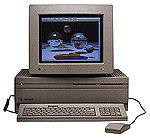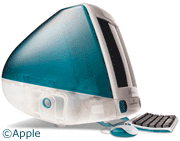Mac Musings
Low End Mac at Three
Daniel Knight - 2000.04.10 -
Last Friday, April 7, was a milestone for Low End Mac. That was the third anniversary of putting the New Low End User Site on my personal web space. The site began with a focus on 68000- through 68030-based Macs from the Plus forward, excluding portables. The entire site was strong on data, sparse on graphics, and simple in design - and the April 1997 version of Low End Mac is now a historical subsection of the larger sit.
 At that point I was working as the Information
Systems Manager at Baker Book
House (as I do today), where we were just retiring our second
round of Macs, after selling off our Plus the previous year. I had just
purchased a Mac II (with 17" 1-bit
b&w monitor), an LC, and an LC II. Added to my Centris 610 and my wife's PowerBook 150, we were well on our way to
creating a family computer network. That Mac II was my first mail
and web server.
At that point I was working as the Information
Systems Manager at Baker Book
House (as I do today), where we were just retiring our second
round of Macs, after selling off our Plus the previous year. I had just
purchased a Mac II (with 17" 1-bit
b&w monitor), an LC, and an LC II. Added to my Centris 610 and my wife's PowerBook 150, we were well on our way to
creating a family computer network. That Mac II was my first mail
and web server.
Already from the beginning I used the Verdana typeface on my site. I still love it. I think it and Internet Explorer 5.0 are two of the best things Microsoft has ever created. And Verdana is one of the few things about LEM that has never changed.
The name evolved from "The New Low End User Site" (named in honor of the defunct Low End User ezine) to "The New Low End Mac User Site" and eventually settled on that familiar trio of three letter, one syllable words, "Low End Mac."
With the name changes came an expanded focus. By June we covered PowerBooks and Quadras. We later added Power Macs, then backtracked for the 128, 512, and Lisa.
It was July 1997 that I discovered my ISP had site stats available. That month I served up over 20,000 pages of content; at this point, we've had a few days with that much traffic!
July 1997 was also the month I posted my first Low End Mac editorial, Gil Amelio: Facts & Speculation. I tried to separate the facts from the rumors and speculation that had arisen in the week since his resignation. Rereading my analysis today, I'm still very pleased with my debut column.
The same day I published a critique and parody of a then-current Microsoft ad asking, "Can you plug all types of people into one type of computer?" You can guess my conclusion: Yes, as long as it comes from Apple.
Editorial content was not a strong feature of LEM in 1997. Other columns included one explaining what products I'd make if I ran Apple, a pair of articles on clones, one on Rhapsody (later known as OS X), and Macintosh Support at Yale, a response to Dan Updegrove's unilateral decision to ditch the Mac.
 Of course, at the same time Steve Jobs was reinventing
Apple. The Power Macintosh G3 came out
in November 1997, and the iMac was
announced just six months later. Yale never did drop Mac support,
and today Apple remains a major player in the education market.
Of course, at the same time Steve Jobs was reinventing
Apple. The Power Macintosh G3 came out
in November 1997, and the iMac was
announced just six months later. Yale never did drop Mac support,
and today Apple remains a major player in the education market.
Low End Mac grew with it. After all, each new model means that many more people owning discontinued designs.
The same month Apple introduced the G3, Low End Mac moved from my personal web space to the MacTimes Network, where I learned that you can make money on the Web. (Before you get too excited about the prospect, let me note that my net for 1999 was about $100 per week, or $3-4 per hour for my 25-30 hour weeks.)
Traffic jumped from 21,000 pages in October to nearly 60,000 in December, thanks to new content, a higher profile, and learning how to send out PR mailings. I was named editor in chief at MacTimes, where I helped bring other sites into the fold.
But it was a rocky year. Promises made; promises broken. The whole thing blew up between December 1998 and March 1999 as writers and sites pulled out, tired of waiting for promised money.
Low End Mac moved from the MacTimes server to lowendmac.com in February 1999, then left MacTimes completely at the end of March. We remained an independent site until September, when we registered the lowendmac.net domain and joined the infiniMedia Network. (Last I checked, MacTimes still owns the lowendmac.com domain, although we are having traffic rerouted to the current site.)
We also added a good selection of writers in 1999, beginning with Evan on the iMac Channel. His first article, iMac iMproved, appeared on January 18, 1999. He has since published over three dozen articles on Low End Mac and also runs his own site, Evansite.
Over the course of the year, Paulo Rodrigues (2/24), Charles W. Moore (9/9), Eric DeStefano (9/27), Steve Wood (9/28), and Rodney O. Lain (10/4) joined our writing staff. So far this year, they have been joined by Brian Rumsey (2/8), Kel Taylor (3/7), and David Schultz (4/7).
But perhaps the biggest reason Low End Mac absolutely took off when it did was the Mac Daniel column, which I launched on October 20, 1998. It got so popular, I couldn't keep up with the email. I ended up putting it on hiatus at the end of June 1999. After some thought, I resurrected it with a small staff of dedicated Mac fans to handle the incoming email. Charlie, Chris, Julie, and Manuel have done a great job offering practical advice for those with older Macs.
Not only that, but Mac Daniel is a real hit magnet. That may sound crass, but you have to remember that the site's original goal is support of older Macs. It's great to see over 20,000 hits per month in this area. Best of all, the older article remain available. Some of those see more traffic today than they did when first published.
I look at my site stats to verify this. The busiest pages aren't the iMac, iBook, G4, and PowerBook pages. Instead, top traffic goes to the Power Mac 6100, a computer discontinued five years ago. Other "top" models are the 7100 (3/94-8/95), Color Classic (2/93-5/94), Quadra 630/Performa 630 (7/94-4/95), 7200 (8/95-4/96), and Quadra 605/Performa 475 (10/93-10/94).
I can also look at the Low End Mac family of email lists to verify the popularity of older Macs. The busiest lists cover Vintage Macs (pre-Quadra), Power Macs (pre-G3), Quadras, Umax SuperMacs, and Compact Macs (such as the Plus and Color Classic).
Three years into Low End Mac, I believe we've definitely found our niche. A few other sites offer the same kind of model-by-model specs, several sites offer more details on a specific model or range of models, and a lot offer a broader range of new links each day, but I think the emphasis on getting the most value from new Macs and old differentiates us from the rest of the pack.
As we approach 500,000 hits per month with 125,000 unique visitors, I think a lot of people agree.
I can hardly wait to see what the next three years will bring.
Join us on Facebook, follow us on Twitter or Google+, or subscribe to our RSS news feed
Dan Knight has been using Macs since 1986, sold Macs for several years, supported them for many more years, and has been publishing Low End Mac since April 1997. If you find Dan's articles helpful, please consider making a donation to his tip jar.
Links for the Day
- Mac of the Day: Mac IIci, introduced 1989.09.20. The fastest Mac to date, the 25 MHz IIci was a real workhorse and a big hit.
- Support Low End Mac